
12 December, 2023
Choosing the Right Glassware for Different Beverages
In the diverse world of beverages, the choice of glassware plays a pivotal role in accentuating the drink's flavour, aroma, and overall experience. But with various glassware options available, how do you choose the perfect glass for each beverage? In this article, we delve deep into the science and the art of matching the right glassware to different beverages, guiding you towards an enhanced drinking experience.
Wine Glasses

1) Red Wine Glasses
In the sophisticated world of wine drinking, red wine glasses hold a place of reverence. They are an instrument that brings out the intricate notes of red wines. Here is a detailed look into the distinctive features of red wine glasses and their role in amplifying the enjoyment of red wines:
Design Characteristics
- Wider Bowl and Larger Opening: These glasses are often designed with a wider bowl and a larger opening, a design steeped in functionality. This expansive structure encourages oxidation, a process vital in unveiling the wine's rich array of flavours and aromas.
- Bowl Shape: The generous bowl shape allows for better swirling. Swirling the wine facilitates the proper mixing of oxygen, enhancing the wine's natural aromas and enriching the tasting experience.
Enhanced Aroma Experience
- Aroma Amplification: The wider opening makes for a larger surface area, allowing the wine to breathe and release many aromas. This design, thus, is no accident; it is an intentional feature that seeks to amplify the bouquet of red wines, bringing forward notes that might be lost in a narrower glass.
Temperature Maintenance
-The wider bowl helps maintain the wine's temperature, keeping it at the optimal temperature for a longer period, ensuring its delicate flavours are not lost.
Directed Flow
The wide opening also plays a crucial role in directing the wine to flow to the back of the mouth, which has a higher receptivity to bolder, richer flavours, ensuring that every sip is a harmonious blend of acidity, tannins, and fruity notes, offering a rounded tasting experience.
Types of Red Wine Glasses
- Bordeaux Glass: Often used for fuller-bodied wines, this type of glass has a tall bowl, facilitating the direct flow of wine to the back of the mouth to enjoy the richness of wines like Cabernet Sauvignon and Merlot.
- Burgundy Glass: This glass, on the other hand, has a wider bowl to capture the delicate aromas of lighter red wines such as Pinot Noir, enhancing the complexity and subtlety of the beverage.
2) White Wine Glasses
The nuanced world of white wine demands glasses that mirror its fine subtleties. Their structure and design are not just about aesthetics; they play a pivotal role in accentuating the delicate attributes of white wines, providing a platform where they can shine in all their nuanced glory.
Design Characteristics
- Narrower Bowl: These glasses traditionally feature a narrower bowl than their red wine counterparts. This design choice aids in maintaining a cooler temperature, which is often preferred for white wines, preserving the crisp, fresh characteristics of the wine.
- Tapered Rim: The glasses often come with a slightly tapered rim, focusing the aromatic molecules efficiently and guiding them seamlessly towards your nose, ensuring a fuller aromatic experience with each sip.
Enhanced Aroma Experience
The narrower construction of the glass naturally concentrates the aromas, drawing out the intricate, sometimes elusive, floral and fruity notes present in white wines.
Temperature Preservation
The slim design minimizes the surface area, which aids in preserving the temperature of the wine, a critical factor in enjoying white wines at their optimum taste profiles.
Directed Flow
Flow to the Front of the Mouth: The design of the white wine glass facilitates the flow of wine to the front of the mouth, allowing the drinker to appreciate the wine's acidity and crispness, which is a distinguished characteristic of white wines. This targeted flow enhances the perception of a white wine's brightness and freshness.
Types of White Wine Glasses
- Chardonnay Glass: These glasses tend to have a slightly wider bowl, allowing the rich and buttery notes of Chardonnays to unfold beautifully, offering a full-bodied experience.
- Sauvignon Blanc Glass: This glass, in contrast, is narrower, ideal for capturing the vibrant, zesty attributes of wines like Sauvignon Blanc, offering a lively, refreshing taste experience.
3) Sparkling Wine Glasses
Sparkling wines, known for their vibrant and effervescent character, require glasses that can uphold their bubbly personality and subtle aromatic notes. These glasses are crafted to maintain the beverage’s freshness and lively sparkles.
Design Characteristics
- Flute Glass: This is the most iconic glass for sparkling wines, featuring a tall, narrow bowl designed to retain the bubbles in the wine for a longer period, showcasing the beauty of the bubbles rising to the top.
- Tulip Shape: Some sparkling wine glasses bear a tulip shape, slightly wider in the middle, allowing for better aroma release than the conventional flute while maintaining the visual spectacle of the bubbles.
- Stemmed Glasses: These glasses come with long stems, preventing the heat from the hand from warming the wine, thus preserving the ideal serving temperature of sparkling wines.
Preserving the Bubbles
The narrow design significantly helps preserve the effervescence of the wine, retaining the bubble finesse and sparkling character of the wine, which is a hallmark of sparkling wines.
Visual Appeal
The elongated shape of the glass showcases the stream of bubbles, adding to the visual appeal and the celebratory mood that sparkling wines often evoke.
Enhancing the Aromatic Profile
Even though flute glasses are narrower than still wine glasses, they still facilitate the concentration of the wine's delicate aromas, offering a pleasurable olfactory experience before every sip.
Sipping Experience
The narrow opening of sparkling wine glasses directs the flow of wine to the tip of the tongue, allowing the palate to appreciate the refreshing acidity and the vibrant, sparkling texture that dances gracefully in the mouth.
Beer Glassware
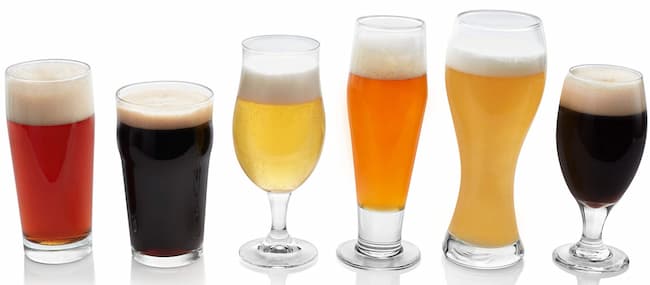
1) Pilsner Glasses
Designed with a slender and tall physique, these glasses are the quintessential companion for pilsners and other light beers. The attributes of pilsner glasses offer several advantages:
- Showcasing brilliance: The slim design prominently showcases the beer's colour, clarity, and effervescence.
- Head retention: A slightly wider top encourages the maintenance of a frothy head, which looks appealing and promotes aromatics retention.
- Aromatics: Its shape facilitates a concentrated delivery of aromas, which is essential in enjoying light beers that often have subtle notes.
2) Stout and Porter Glasses
These glasses have a more substantial build, created to enhance the experience of enjoying stouts and porters' rich and deep flavours. Key features of these glasses are:
- Broad bowl: Designed to bring out the rich aromas of stout and porter beers, it invites a deeper appreciation of their complex profiles.
- Tapered top: The narrowing top assists in retaining the beer’s head, which helps maintain the bouquet of aromas and offers a richer taste with each sip.
3) IPA Glasses
IPA or India Pale Ale glasses are generally tapered and often have a stem to maintain the temperature and are engineered to bring out the hops and complex flavours of IPAs. Here are their features:
- Bowl shape: Enhances volatile organic compounds' evaporation to boost the hop aroma.
- Rim design: Directs the beer to specific palate areas to emphasise different flavour notes.
4) Weizen Glasses
Traditionally used for wheat beers, Weizen glasses have notable characteristics that make them suited for wheat beer varieties:
- Tall and slender: Allows proper head formation and retention, preserving the bubbles and the aromas longer.
-Wider top: Facilitates easy pouring, which is especially beneficial for wheat beers with thick, foamy heads.
5) Tulip Glasses
These glasses have a bulbous body and a flared lip, working wonderfully with Scottish ales, barleywines, and Belgian ales. Here are their features:
- Bulbous body: Enhances aroma concentration, allowing enthusiasts to fully appreciate the beverage's aromatic complexity.
- Flared lip: Promotes better sipping, enabling a smoother drinking experience while emphasising the beer’s sweetness on the palate.
6) Goblet and Chalice Glasses
These substantial, stemmed glasses are ideal for heavy, malty beers. Features include:
- Wide mouth: Allows large sips and makes detecting nuances in the aroma easier.
- Stemmed base: Ensures the hand’s heat doesn’t warm the beer, maintaining its optimal temperature.
Spirits and Cocktails
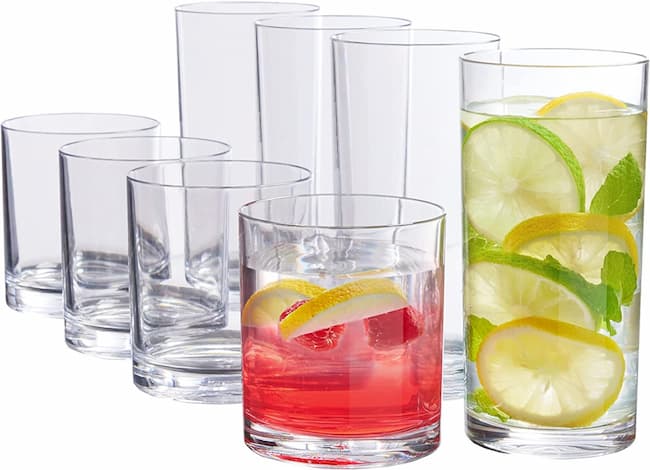
1) Highball Glasses
These tall, straight-sided glasses are the go-to for cocktails and mixed drinks. Here are the features that make them a popular choice in the beverage industry:
- Tall Structure: Their tall and narrow shape allows for more mixer to be added, making it the preferred choice for drinks served with a high ratio of mixer to spirit.
- Volume: Generally holding between 240 to 350 millilitres, they can comfortably house ice, spirit, and mixers without overcrowding the glass.
- Presentation: The tall form provides an elegant and elongated appearance, offering a sophisticated presentation for cocktails.
- Versatility: Besides cocktails, it is also perfect for serving non-alcoholic beverages such as juices and soft drinks, making them a versatile addition to your glassware collection.
2) Lowball Glasses
Also known as old-fashioned or rocks glasses, these are stout vessels designed primarily for spirits. Let's look at what sets them apart:
- Short and Wide: Lowball glasses are shorter and wider than highball glasses, typically holding 180 to 240 millilitres of liquid. This design is perfect for cocktails with a smaller mixer volume or for drinks served "on the rocks".
- Thick Base: Many lowball glasses feature a thick base, providing a weighty and stable vessel that is excellent for muddled cocktails, as it facilitates mashing ingredients using a muddler.
- Aromatic Amplification: The wide opening allows the aromatic compounds of the spirit to open up, providing a rich olfactory experience before each sip.
- Presentation: Its broad structure allows for a creative presentation of cocktails, with ample space for garnishes and ice artistry, enhancing the drink's visual appeal.
Understanding the nuances between highball and lowball glasses can uplift the drinking experience, as each glass type is crafted to bring out the best qualities of different beverages, be it in terms of taste, aroma, or presentation.
Martini Glasses
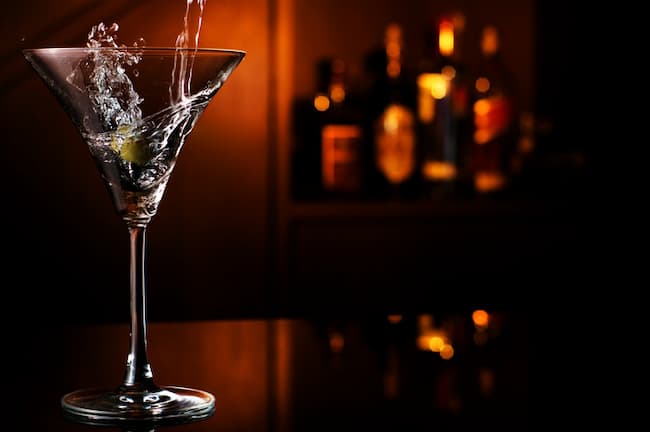
Martini glasses, iconic in their design, are essentially crafted to elevate the martini drinking experience.
- Wide Bowl: The wide bowl of the martini glass serves a crucial function: it provides ample surface area for the drink, facilitating the release of the beverage's aromas and allowing the drinker to fully appreciate the cocktail’s intricate flavours through taste and smell. It also offers plenty of room for garnishes, letting bartenders get creative with the drink's presentation.
- Stemmed Handle: The stemmed handle or base of the martini glass is not just for aesthetic appeal. Holding the glass by the stem prevents heat from the hand from warming the contents of the glass, helping to keep the drink cold for a longer period. This feature is essential as martinis and other cocktails served in this glass are typically chilled.
- Angled Rim: The rim is angled, creating a wide opening that elegantly showcases the cocktail, inviting drinkers to fully appreciate the visual aspects, including the clarity and colour of the drink. The wide rim also facilitates easy sipping, directing the liquid to the tip of the tongue, where sweet and sour tastes are best appreciated.
- Versatility: While originally designed for martinis, these glasses are also used to serve other cocktails like Manhattans and Cosmopolitans, providing a stylish and sophisticated touch to a wide range of cocktails.
- Elegant Presentation: Their distinctive design adds a touch of elegance and sophistication to any occasion. Their unique shape, with a broad bowl and narrowing stem, makes them a visually appealing choice, adding a flair of sophistication to the drinking experience.
Whiskey Glasses
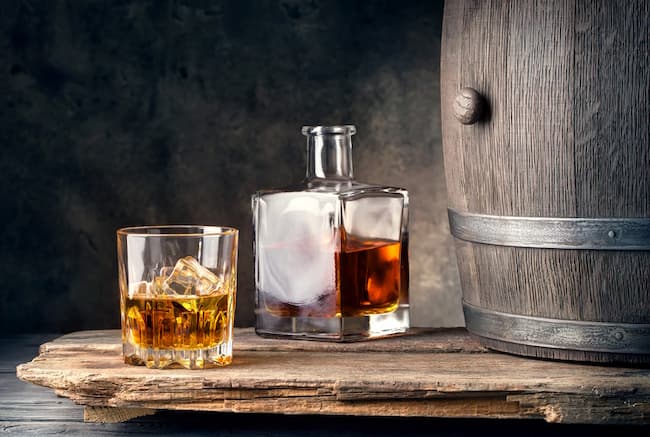
Whiskey glasses are designed to enrich the drinking experience by enhancing the visual appeal and concentrating the aromas and flavours of the whiskey. Here we detail the distinctive features and the impact they have on the whiskey-drinking experience:
- Wide Base: The wide base serves several functions. It provides a stable foundation for the glass, reducing the risk of spills. Additionally, it allows for a comfortable grip, enhancing the drinking experience. This wide base is also conducive to swirling the whiskey, facilitating the release of its rich and complex aromas.
- Narrowing Top: The design narrows towards the top, a feature that helps concentrate the aromas of the whiskey, allowing for a richer olfactory experience before taking a sip. This aroma concentration significantly enhances the whiskey's flavour profile as our sense of smell strongly influences our taste perception.
- Thick Glass: They often feature a thicker glass construction than other glassware types. This adds to the glass's durability and offers a pleasing heft in the hand, which many whiskey enthusiasts appreciate.
- Versatility in Designs: They come in various designs, including the traditional tumbler, the Glencairn glass, and the whiskey snifter, each offering a slightly different whiskey appreciation experience. The choice of glass can depend on personal preference and the type and age of the whiskey being served.
- Facilitating Tasting Notes: Their shape, particularly ones that narrow towards the top, encourages sippers to take smaller sips and slowly let the spirit wash over the palate. This reveals the whiskey's complex profile and encourages drinkers to appreciate the spirit’s different tasting notes, adding depth to the tasting experience.
Shot Glasses
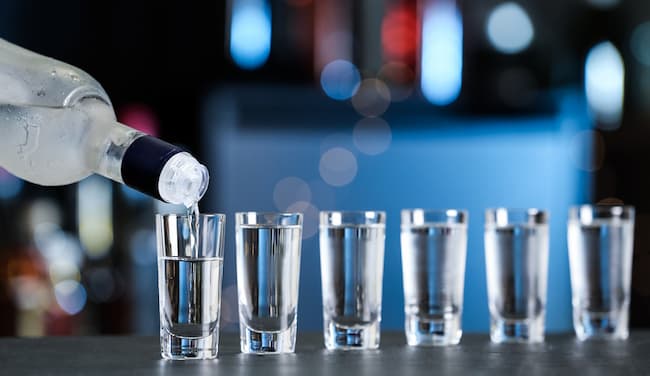
Shot glasses are designed to hold or measure spirits or liquor, often consumed quickly or "shot" back. Despite their simple, straightforward purpose, an interesting variety of designs and specifics can affect the drinking experience.
Traditional Shot Glasses
These are generally small, thick-walled glasses designed to hold around 1.5 to 2.5 ounces of liquor. The sturdy design makes it ideal for quick consumption, facilitating a quick service of shots, especially in busy settings like bars and parties.
Double Shot Glasses
For those who prefer a more generous serving, double shot glasses are available, which can hold up to 2 to 3 ounces of liquor, allowing for a double shot serving which is perfect for cocktails that require a substantial amount of liquor.
Tall Shot Glasses
These glasses are taller than the standard shot glasses and great for recipes requiring layered shots, where different liquors are poured carefully to create distinct layers. The tall design makes the layers more distinctly visible, creating a visually pleasing and delightful drinking experience.
Conclusion
Choosing the right glassware for different beverages is a fine art that balances aesthetics, functionality, and sensory experience. By understanding the unique characteristics of each type of glassware, you can enhance the taste, aroma, and enjoyment of your favourite beverages, elevating each sip to a delightful symphony of sensory pleasure. So, the next time you pour a drink, remember that the perfect glassware can uplift your drinking experience, transforming it from mundane to magnificent.
The Glassware Only Team



